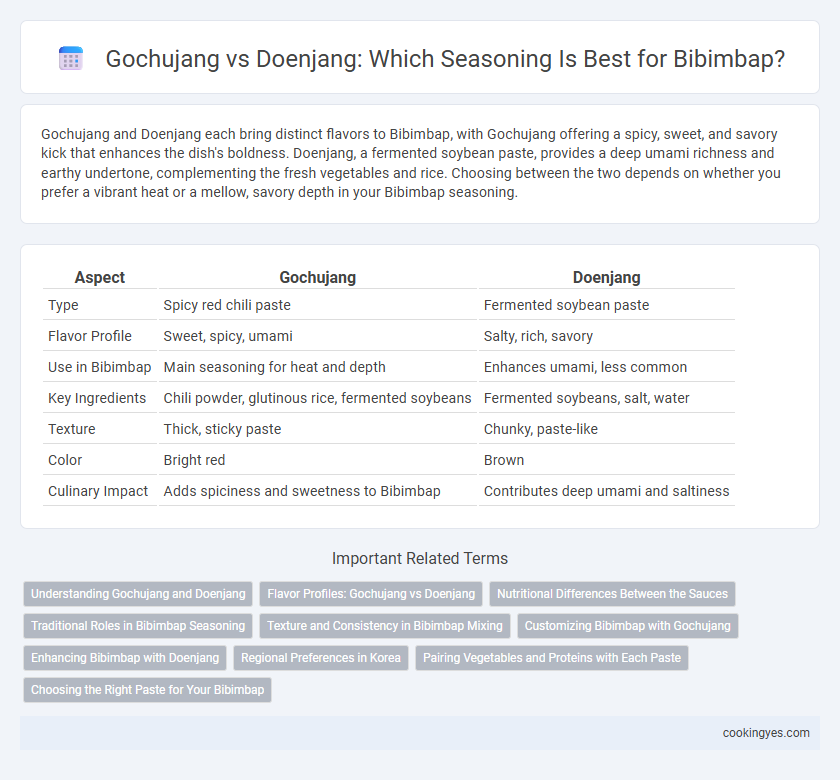Gochujang and Doenjang each bring distinct flavors to Bibimbap, with Gochujang offering a spicy, sweet, and savory kick that enhances the dish's boldness. Doenjang, a fermented soybean paste, provides a deep umami richness and earthy undertone, complementing the fresh vegetables and rice. Choosing between the two depends on whether you prefer a vibrant heat or a mellow, savory depth in your Bibimbap seasoning.
Table of Comparison
| Aspect | Gochujang | Doenjang |
|---|---|---|
| Type | Spicy red chili paste | Fermented soybean paste |
| Flavor Profile | Sweet, spicy, umami | Salty, rich, savory |
| Use in Bibimbap | Main seasoning for heat and depth | Enhances umami, less common |
| Key Ingredients | Chili powder, glutinous rice, fermented soybeans | Fermented soybeans, salt, water |
| Texture | Thick, sticky paste | Chunky, paste-like |
| Color | Bright red | Brown |
| Culinary Impact | Adds spiciness and sweetness to Bibimbap | Contributes deep umami and saltiness |
Understanding Gochujang and Doenjang
Gochujang, a fermented red chili paste, provides Bibimbap with a spicy, sweet, and savory flavor balanced by its thick, sticky texture, adding depth and heat to the dish. Doenjang, a fermented soybean paste, offers a rich, earthy, umami taste with a saltier and more intense profile, often enhancing Bibimbap's savory complexity. Understanding the distinct fermentation processes--gochujang made from chili powder, glutinous rice, and soybeans, and doenjang from fermented soybeans alone--clarifies their unique contributions to Bibimbap's seasoning.
Flavor Profiles: Gochujang vs Doenjang
Gochujang offers a spicy, sweet, and slightly fermented flavor that enhances Bibimbap with a vibrant heat and umami depth. Doenjang provides a rich, earthy, and savory taste derived from fermented soybeans, lending a deeper, more robust seasoning to the dish. Choosing between Gochujang and Doenjang influences Bibimbap's flavor profile, balancing between bold spice and mellow umami richness.
Nutritional Differences Between the Sauces
Gochujang, a fermented red chili paste rich in capsaicin and antioxidants, provides a spicy kick while boosting metabolism and offering vitamins like B2 and C. Doenjang, a soybean paste, contains higher protein, essential amino acids, and probiotics, supporting gut health and aiding digestion. Choosing between Gochujang and Doenjang in bibimbap affects not only flavor but nutritional profiles, balancing benefits of heat and metabolism with digestive and protein support.
Traditional Roles in Bibimbap Seasoning
Gochujang, a fermented red chili paste, traditionally provides Bibimbap with its characteristic spicy and sweet flavor, enhancing the dish's vibrant taste profile. Doenjang, a fermented soybean paste, offers a deeper umami and earthy undertone, often used in Bibimbap variations to add savory complexity. While Gochujang is more commonly associated with classic Bibimbap seasoning, Doenjang serves as a complementary or alternative seasoning in regional and vegetarian Bibimbap recipes.
Texture and Consistency in Bibimbap Mixing
Gochujang offers a thick, sticky texture that blends smoothly with the rice and vegetables, creating a creamy consistency that enhances each bite of bibimbap. Doenjang has a chunkier, grainier texture, giving the dish a heartier feel while leaving distinct seasoning pockets throughout the mix. The choice between gochujang's velvety consistency and doenjang's rustic texture significantly influences the overall mouthfeel and flavor integration of bibimbap.
Customizing Bibimbap with Gochujang
Gochujang, a spicy red chili paste, is the preferred seasoning for customizing bibimbap, offering a bold, tangy flavor that complements the mixed vegetables, rice, and meat. Its combination of fermented soybeans, glutinous rice, and chili peppers adds a unique umami and heat profile that enhances the dish's complexity. Unlike doenjang, which provides a deeper, earthy soy flavor, gochujang is ideal for those seeking a vibrant and spicy kick in their bibimbap.
Enhancing Bibimbap with Doenjang
Doenjang enhances Bibimbap by adding a deep, savory umami flavor that complements the fresh vegetables and rice without overpowering them. Unlike the spicy heat of Gochujang, Doenjang provides a rich, fermented soybean taste that brings out the dish's earthy and nutty notes. This seasoning adds complexity and authenticity to Bibimbap, making it a versatile choice for those seeking a balanced and traditional Korean flavor profile.
Regional Preferences in Korea
Gochujang, a spicy red chili paste, is predominantly favored in the southern regions of Korea, especially in Jeolla and Gyeongsang provinces, for seasoning Bibimbap due to its vibrant heat and sweetness. Doenjang, a fermented soybean paste with a richer umami profile, is more commonly used around the Seoul and Gyeonggi areas, lending a deeper, earthier flavor to the dish. These regional preferences reflect Korea's diverse culinary traditions and influence the overall taste experience of Bibimbap across different areas.
Pairing Vegetables and Proteins with Each Paste
Gochujang, a spicy red chili paste, pairs exceptionally well with beef, chicken, or pork and crunchy vegetables like spinach, bean sprouts, and cucumbers, enhancing the bibimbap with a bold, fiery flavor. Doenjang, a fermented soybean paste, complements milder proteins such as tofu or mushrooms and earthy vegetables like zucchini and mushrooms, adding a deep, umami richness. Choosing gochujang or doenjang depends on the desired heat level and flavor depth, with gochujang offering vibrant spice and doenjang providing savory complexity.
Choosing the Right Paste for Your Bibimbap
Gochujang, a spicy and slightly sweet red chili paste, is the most popular choice for seasoning bibimbap, delivering a vibrant kick that enhances the dish's bold flavors. Doenjang, a fermented soybean paste, offers a deeper umami taste and earthiness, making it ideal for those seeking a richer, more savory profile. Selecting between gochujang and doenjang depends on whether you prefer a spicy sweetness or a robust, fermented flavor to complement your bibimbap ingredients.
Gochujang vs Doenjang for seasoning Bibimbap Infographic

 cookingyes.com
cookingyes.com